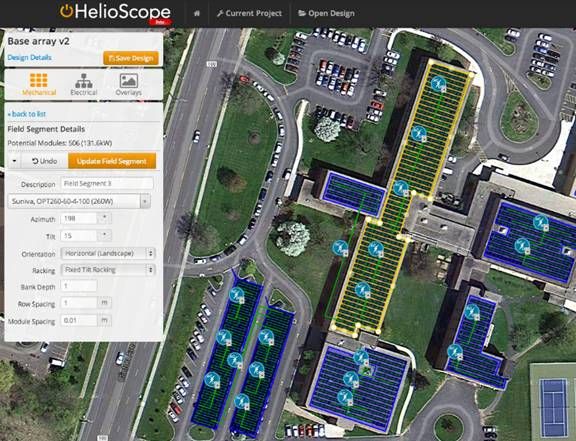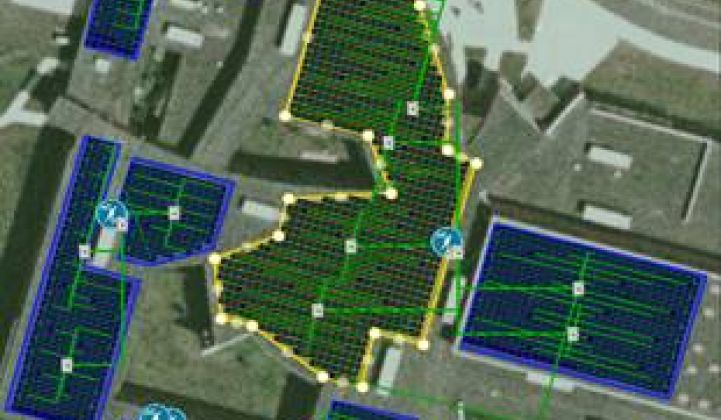Solar funders have a new tool for measuring the bankability of a commercial- or utility-scale PV installation.
HelioScope, from Folsom Labs, is a cloud-based software program created to replace PVsyst, the energy modeling tool that is now the industry standard. Paul Gibbs, CEO of Folsom Labs, said the software is designed to be much easier and less expensive to use than PVsyst.
“To use PVsyst for energy modeling, developers have to begin with AutoCAD to design the project. With HelioScope, the designer can lay out a rooftop in a few minutes and get the energy modeling for free,” said Gibbs.
HelioScope uses the same underlying math as its competitor. But with PVsyst, the designer has to provide a range of engineering-level variables to derive the energy output, said Gibbs. With HelioScope, a designer simply inputs "the physical objects, location, and positioning,” according to Gibbs.
The importance of validating a PV installation’s bankability is what makes HelioScope so useful, said Folsom Labs co-founder Paul Grana.
“Bankability is the minimum requirement for a developer,” Grana said. With HelioScope, the developer can just input the array's layout in order to determine its bankability.
The current version of the report generated by HelioScope provides the necessary energy output calculation, but does not provide financial modeling. A recently awarded DOE SunShot grant will allow Folsom Labs to add two features that will automatically select the best design. "Not necessarily the one that produces the most energy," Gibbs said, "but the one that produces the most energy at the lowest LCOE.”
PVsyst founder and creator André Mermoud declined a request for comment on HelioScope because he had not yet evaluated it.
HelioScope “demonstrates agreement with PVsyst modeling results to within 1 percent,” according to BEW Engineering's evaluation of the software. Capabilities like “modeling the array from the module level, employing cloud computing resources on the fly, and interfacing with easy-to-use mapping and structure construction tools make this a package worth watching,” BEW concluded.
HelioScope incorporates optimizers from Tigo and Ampt and “models each module,” Grana explained. PVsyst treats an array "like a single module.” By using the module-level power optimizers, Grana said, HelioScope "does mismatch modeling properly, from the bottom up.”
HelioScope’s report has been used instead of a PVsyst-generated report for five bank-owned projects, ranging from 400 kilowatts to 1.5 megawatts, Grana said. “The BEW Engineering report was a cornerstone of acceptance, because it went through all the variables in the simulation and validated each step in the process.”
Senior PV Design Engineer Kevin West worked with the industry standard combination of PVsyst and AutoCAD for six years at Enfinity, SunEdison, and Conergy. “HelioScope does what both those tools do together, and because it automates so much for you, the amount of time you save is remarkable.”
Another favorable characteristic of the software is its ease of use, West said. He reports that he was able to teach his development team to use it in half an hour, freeing himself up to do more technical work.

“André Mermoud deserves a lot of credit for creating the math that drives the energy production estimation process" within PVsyst, explained Rebekah Hren, curriculum developer for Solar Energy International. But she said HelioScope uses almost the same math and features a more user-friendly layout.
Hren also does project design and has used PVsyst for four years to create and review energy production estimates for financiers. "It’s accurate but hard to use,” she said.
PVsyst is a Windows-based program that is installed on the user’s computer, while HelioScope is cloud-based, she added. That makes it more accessible to Mac users, easier to share, and eliminates concerns about software updates and new versions.
But breaking into the industry with HelioScope and making it competitive with a standard like PVsyst won't be easy.
"Currently, tools like PVsyst are the default standard in the industry, and it will be difficult for new modeling software to overcome that," explained GTM Research Senior Solar Analyst MJ Shiao. "Folsom still has to prove that HelioScope's output matches in-field performance. They're taking the right steps, but it's a process that simply takes time."



